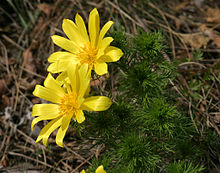Adonis vernalis

Adonis vernalis, known variously as pheasant’s eye, spring pheasant’s eye, yellow pheasant’s eye and false hellebore, is a perennial flowering plant in the buttercup family Ranunculaceae. It is found in dry meadows and steppes in Eurasia. More specifically, this plant grows in a wide range of locations which include open forests, forest clearings, dry meadows, mesic steppe, and mostly calcareous soil. [1] Isolated populations are found from Spain in the west across Central Europe with fine examples in Valais, Switzerland, and southern Europe, reaching southern Sweden in the north and Abruzzo in the south,[2] with its main area of distribution being the Pannonian Basin and the West Siberian Plain.[3] In contrast to most other European Adonis species, the flowers appear in springtime, and are up to 80 mm in diameter, with up to 20 bright yellow petals. Not only do the flowers being to grow, but so do the plants aerial organs, from around April to May.[4]
The plant is poisonous, containing cardiostimulant compounds, such as adonidin and aconitic acid.[5] In addition, it is often used as an ornamental plant.[6] Infusions of the plant are used in the medicine Bekhterev’s mixture.[7]
While the information of therapeutic usages of Adonis vernalis is low, there has been evidence that Adonis vernalis does have potential therapeutic uses, but research is needed to quantify its therapeutic properties. [8]
(Green false hellebore, sometimes also called simply “false hellebore,” is Veratrum viride, a member of the lily family.)
